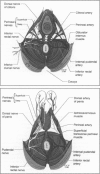Abstract
Normal pelvic floor function involves a set of learned and reflex responses that are essential for the normal control and evacuation of stool. A variety of functional disturbances of the pelvic floor, including incontinence and constipation, are not life threatening, but can cause significant distress to affected patients. Understanding the normal anatomy and physiology of the pelvic floor is essential to understanding and treating these disorders of defecation. This article describes the normal function of the pelvic floor, the diagnostic tools available to investigate pelvic floor dysfunction, and the etiology, diagnosis, and management of the functional pelvic floor disorders that lead to incontinence and constipation.
Full text
PDF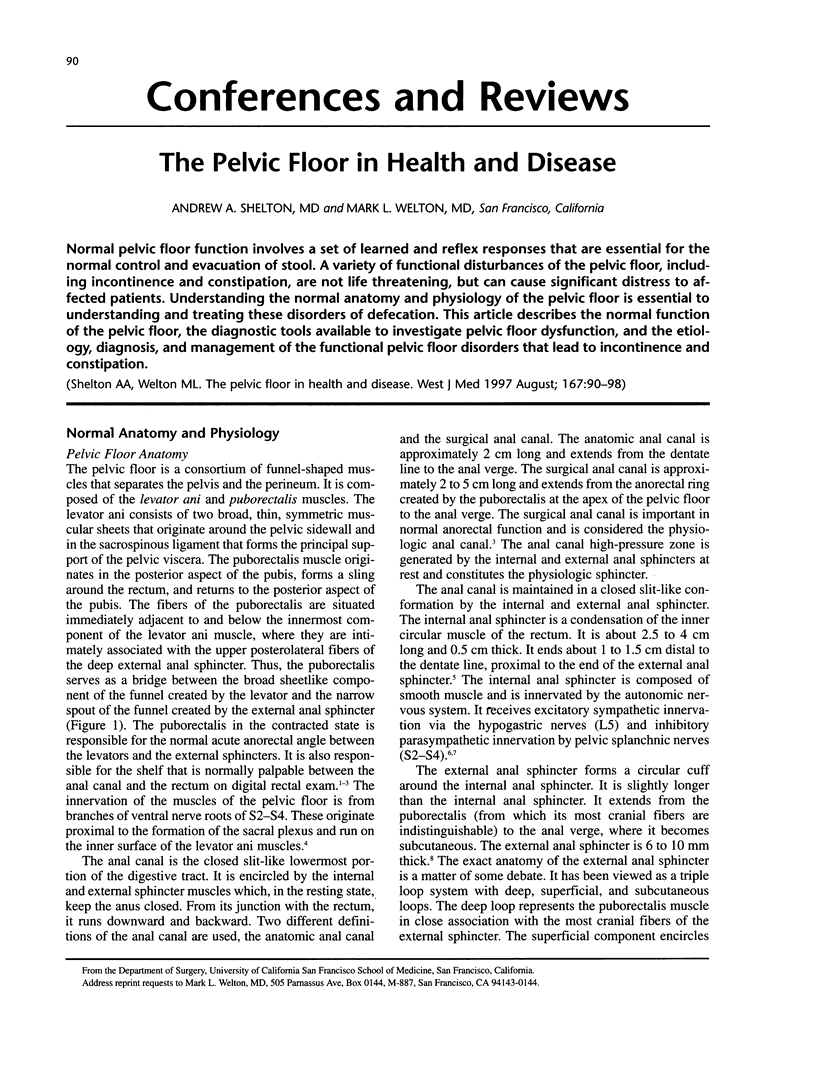
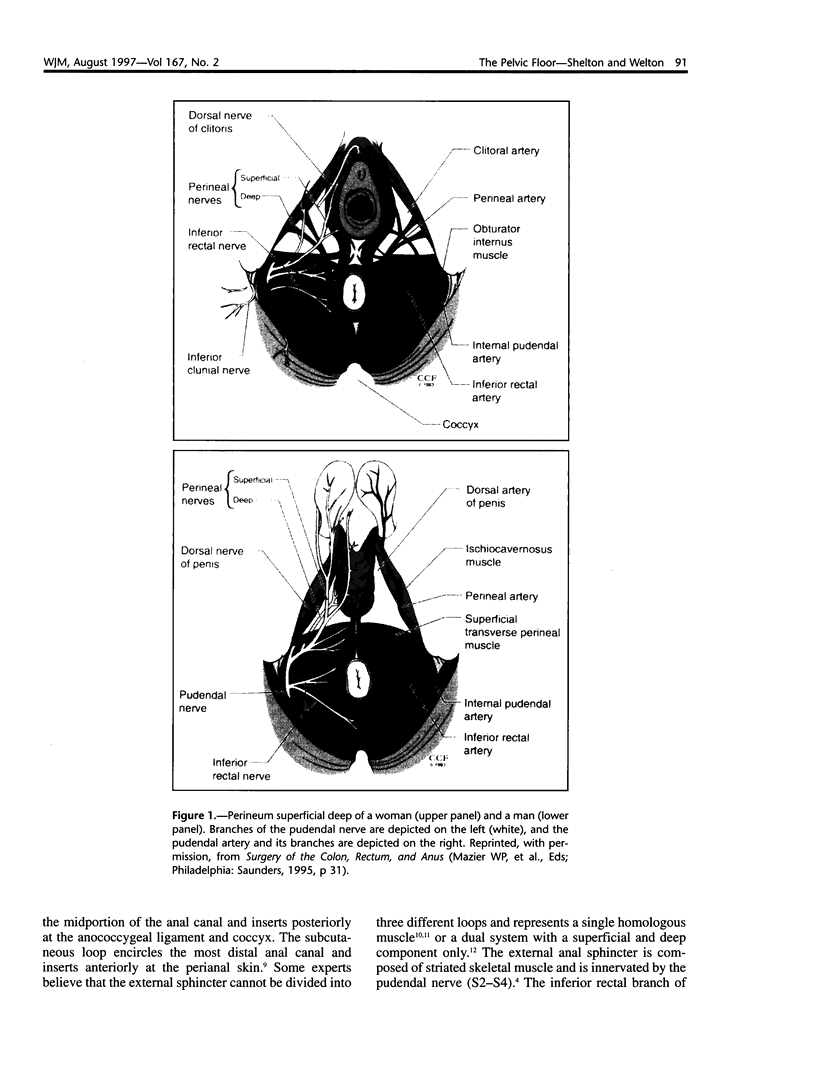
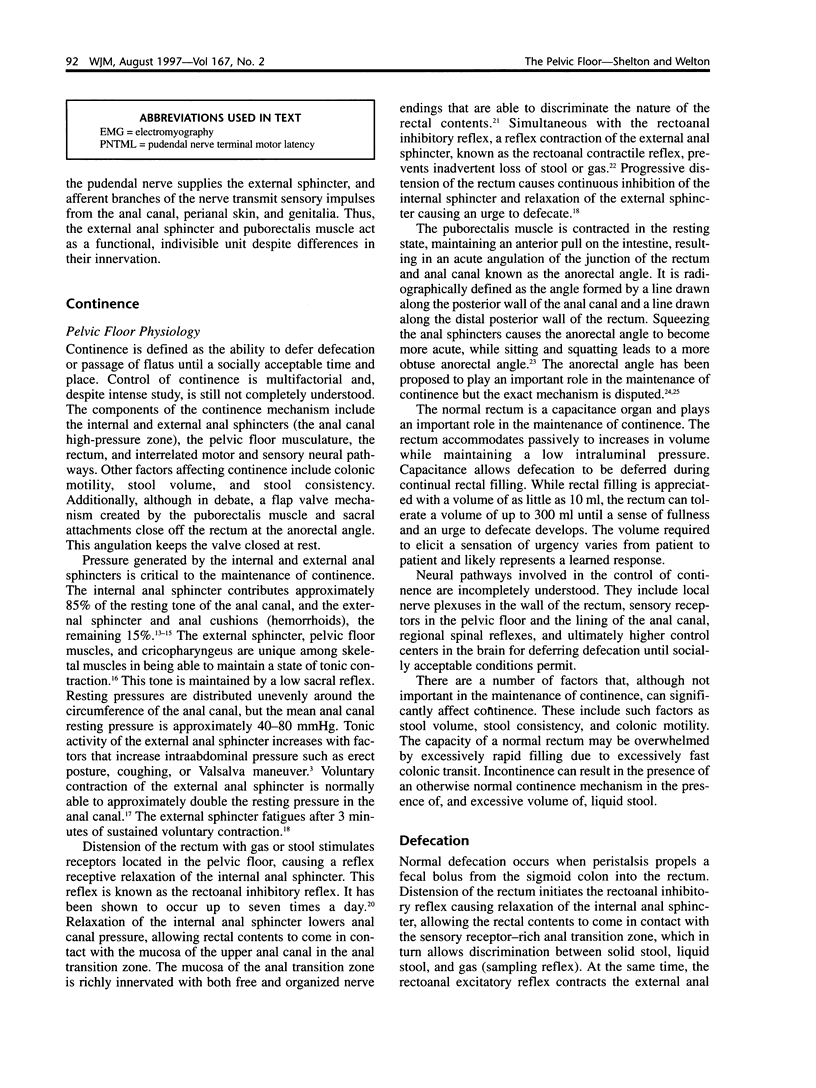
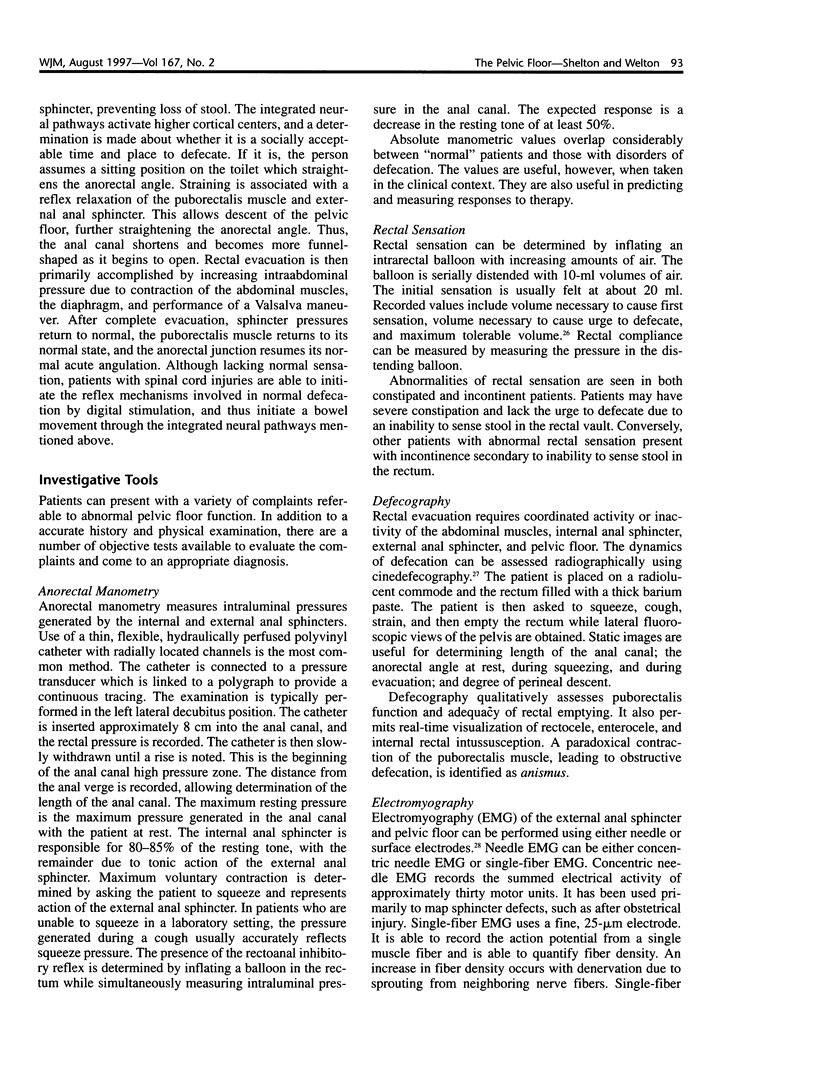
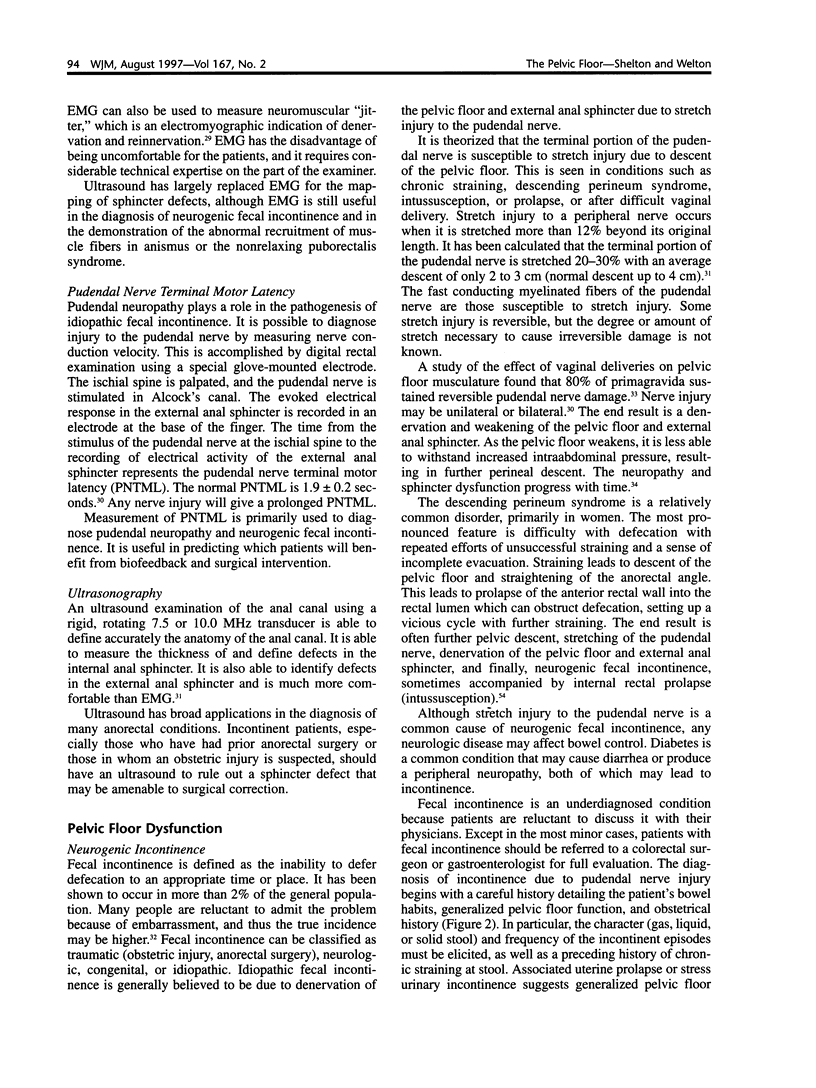
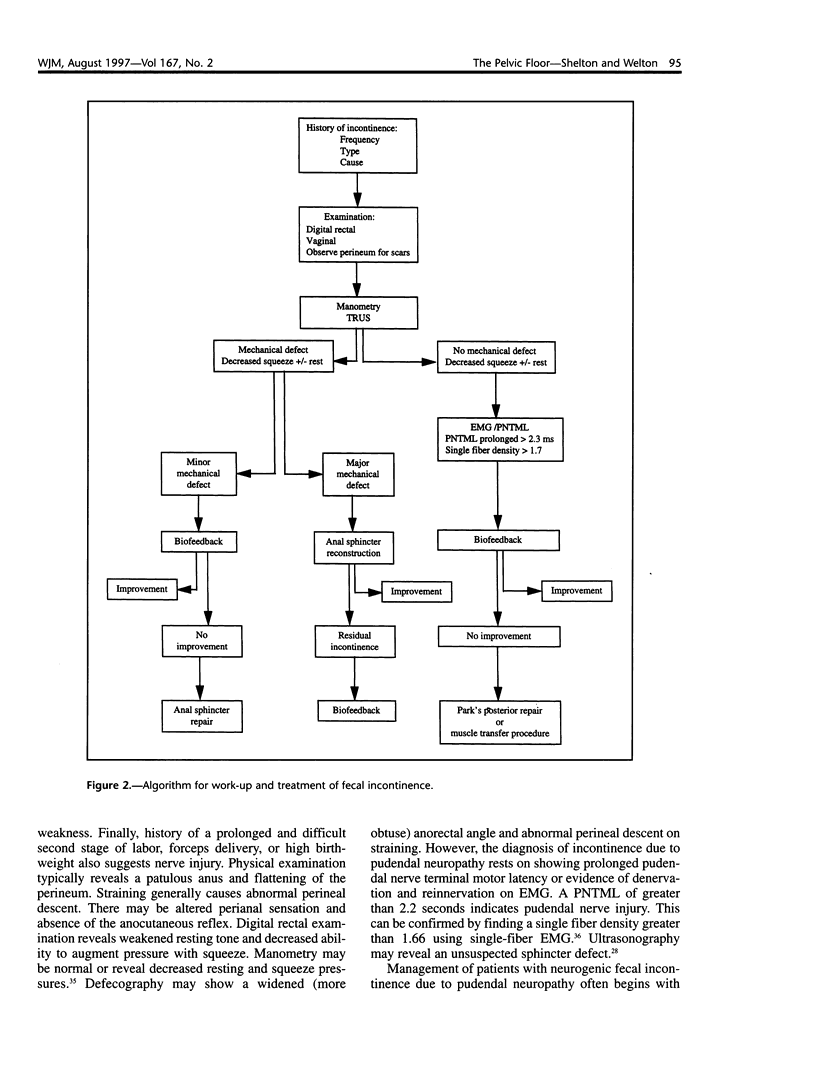
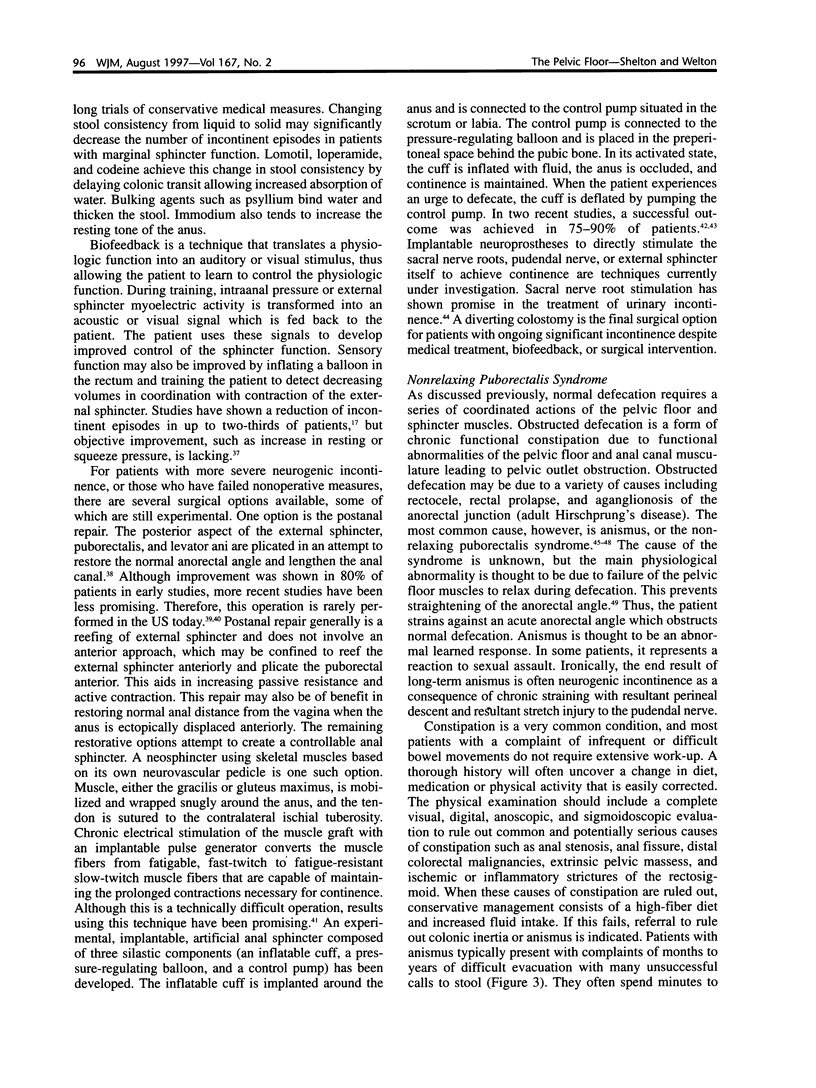
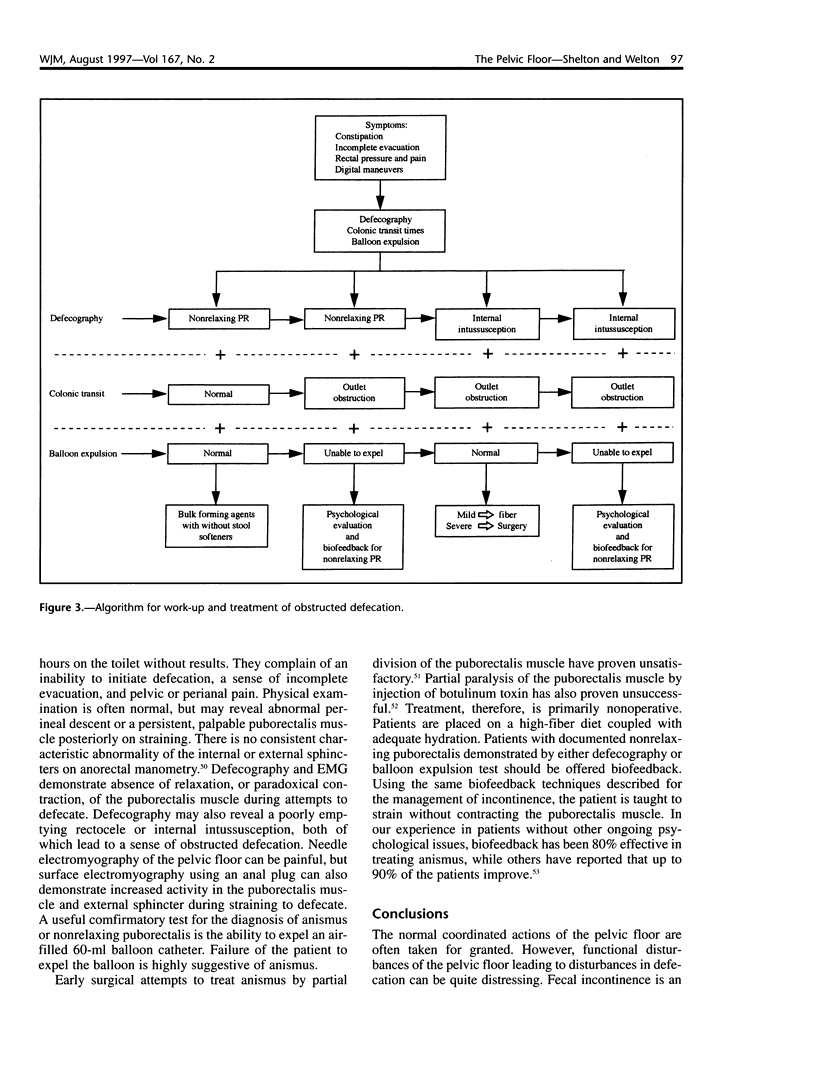
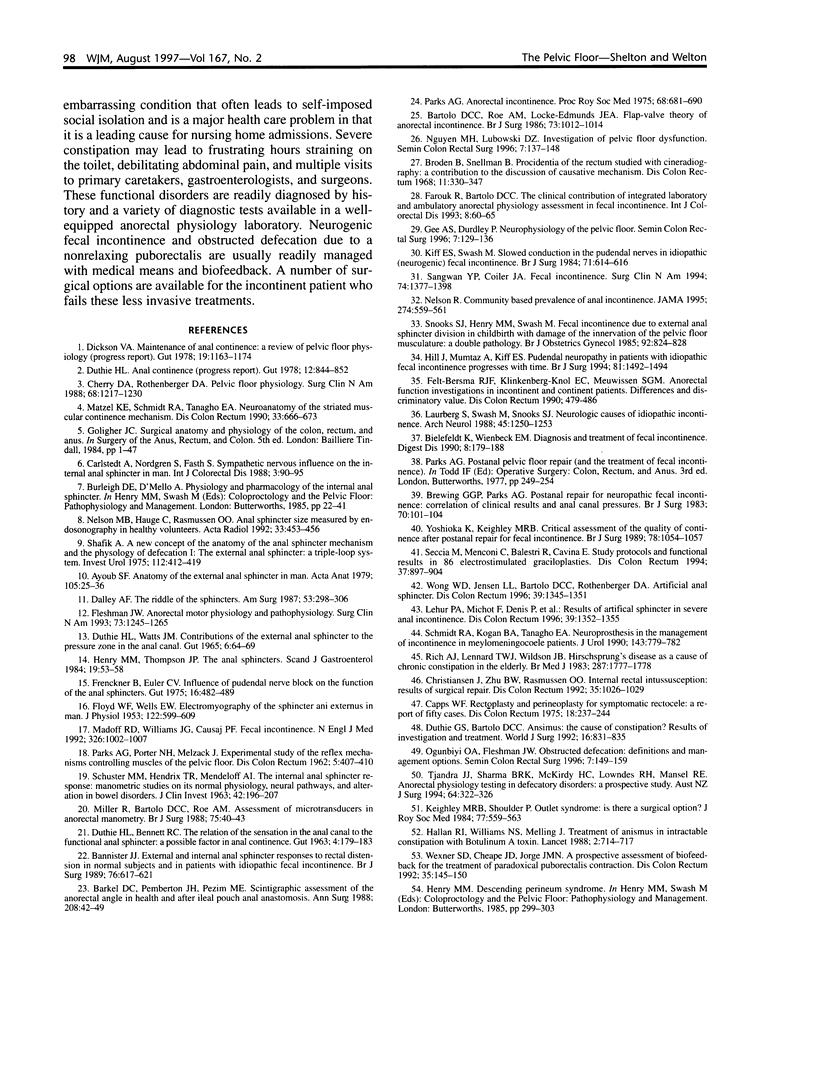
Images in this article
Selected References
These references are in PubMed. This may not be the complete list of references from this article.
- Ayoub S. F. Anatomy of the external anal sphincter in man. Acta Anat (Basel) 1979;105(1):25–36. doi: 10.1159/000145103. [DOI] [PubMed] [Google Scholar]
- Bannister J. J., Read N. W., Donnelly T. C., Sun W. M. External and internal anal sphincter responses to rectal distension in normal subjects and in patients with idiopathic faecal incontinence. Br J Surg. 1989 Jun;76(6):617–621. doi: 10.1002/bjs.1800760632. [DOI] [PubMed] [Google Scholar]
- Barkel D. C., Pemberton J. H., Pezim M. E., Phillips S. F., Kelly K. A., Brown M. L. Scintigraphic assessment of the anorectal angle in health and after ileal pouch-anal anastomosis. Ann Surg. 1988 Jul;208(1):42–49. doi: 10.1097/00000658-198807000-00006. [DOI] [PMC free article] [PubMed] [Google Scholar]
- Bartolo D. C., Roe A. M., Locke-Edmunds J. C., Virjee J., Mortensen N. J. Flap-valve theory of anorectal continence. Br J Surg. 1986 Dec;73(12):1012–1014. doi: 10.1002/bjs.1800731227. [DOI] [PubMed] [Google Scholar]
- Bielefeldt K., Enck P., Wienbeck M. Diagnosis and treatment of fecal incontinence. Dig Dis. 1990;8(3):179–188. doi: 10.1159/000171251. [DOI] [PubMed] [Google Scholar]
- Brodén B., Snellman B. Procidentia of the rectum studied with cineradiography. A contribution to the discussion of causative mechanism. Dis Colon Rectum. 1968 Sep-Oct;11(5):330–347. doi: 10.1007/BF02616986. [DOI] [PubMed] [Google Scholar]
- Browning G. G., Parks A. G. Postanal repair for neuropathic faecal incontinence: correlation of clinical result and anal canal pressures. Br J Surg. 1983 Feb;70(2):101–104. doi: 10.1002/bjs.1800700216. [DOI] [PubMed] [Google Scholar]
- Capps W. F., Jr Rectoplasty and perineoplasty for the symptomatic rectocele: a report of fifty cases. Dis Colon Rectum. 1975 Apr;18(3):237–243. doi: 10.1007/BF02587281. [DOI] [PubMed] [Google Scholar]
- Carlstedt A., Nordgren S., Fasth S., Appelgren L., Hultén L. Sympathetic nervous influence on the internal anal sphincter and rectum in man. Int J Colorectal Dis. 1988 Jun;3(2):90–95. doi: 10.1007/BF01645312. [DOI] [PubMed] [Google Scholar]
- Cherry D. A., Rothenberger D. A. Pelvic floor physiology. Surg Clin North Am. 1988 Dec;68(6):1217–1230. doi: 10.1016/s0039-6109(16)44682-7. [DOI] [PubMed] [Google Scholar]
- Christiansen J., Zhu B. W., Rasmussen O. O., Sørensen M. Internal rectal intussusception: results of surgical repair. Dis Colon Rectum. 1992 Nov;35(11):1026–1029. doi: 10.1007/BF02252991. [DOI] [PubMed] [Google Scholar]
- DUTHIE H. L., WATTS J. M. CONTRIBUTION OF THE EXTERNAL ANAL SPHINCTER TO THE PRESSURE ZONE IN THE ANAL CANAL. Gut. 1965 Feb;6:64–68. doi: 10.1136/gut.6.1.64. [DOI] [PMC free article] [PubMed] [Google Scholar]
- Dalley A. F., 2nd The riddle of the sphincters. The morphophysiology of the anorectal mechanism reviewed. Am Surg. 1987 May;53(5):298–306. [PubMed] [Google Scholar]
- Dickinson V. A. Maintenance of anal continence: a review of pelvic floor physiology. Gut. 1978 Dec;19(12):1163–1174. doi: 10.1136/gut.19.12.1163. [DOI] [PMC free article] [PubMed] [Google Scholar]
- Duthie G. S., Bartolo D. C. Anismus: the cause of constipation? Results of investigation and treatment. World J Surg. 1992 Sep-Oct;16(5):831–835. doi: 10.1007/BF02066978. [DOI] [PubMed] [Google Scholar]
- Duthie H. L., Bennett R. C. The relation of sensation in the anal canal to the functional anal sphincter: a possible factor in anal continence. Gut. 1963 Jun;4(2):179–182. doi: 10.1136/gut.4.2.179. [DOI] [PMC free article] [PubMed] [Google Scholar]
- Duthie H. L. Progress report. Anal continence. Gut. 1971 Oct;12(10):844–852. doi: 10.1136/gut.12.10.844. [DOI] [PMC free article] [PubMed] [Google Scholar]
- FLOYD W. F., WALLS E. W. Electromyography of the sphincter ani externus in man. J Physiol. 1953 Dec 29;122(3):599–609. doi: 10.1113/jphysiol.1953.sp005024. [DOI] [PMC free article] [PubMed] [Google Scholar]
- Farouk R., Bartolo D. C. The clinical contribution of integrated laboratory and ambulatory anorectal physiology assessment in faecal incontinence. Int J Colorectal Dis. 1993 Jul;8(2):60–65. doi: 10.1007/BF00299328. [DOI] [PubMed] [Google Scholar]
- Felt-Bersma R. J., Klinkenberg-Knol E. C., Meuwissen S. G. Anorectal function investigations in incontinent and continent patients. Differences and discriminatory value. Dis Colon Rectum. 1990 Jun;33(6):479–486. doi: 10.1007/BF02052142. [DOI] [PubMed] [Google Scholar]
- Fleshman J. W. Anorectal motor physiology and pathophysiology. Surg Clin North Am. 1993 Dec;73(6):1245–1265. doi: 10.1016/s0039-6109(16)46190-6. [DOI] [PubMed] [Google Scholar]
- Frenckner B., Euler C. V. Influence of pudendal block on the function of the anal sphincters. Gut. 1975 Jun;16(6):482–489. doi: 10.1136/gut.16.6.482. [DOI] [PMC free article] [PubMed] [Google Scholar]
- Hallan R. I., Williams N. S., Melling J., Waldron D. J., Womack N. R., Morrison J. F. Treatment of anismus in intractable constipation with botulinum A toxin. Lancet. 1988 Sep 24;2(8613):714–717. doi: 10.1016/s0140-6736(88)90188-2. [DOI] [PubMed] [Google Scholar]
- Henry M. M., Thomson J. P. The anal sphincter. Scand J Gastroenterol Suppl. 1984;93:53–57. [PubMed] [Google Scholar]
- Hill J., Mumtaz A., Kiff E. S. Pudendal neuropathy in patients with idiopathic faecal incontinence progresses with time. Br J Surg. 1994 Oct;81(10):1494–1495. doi: 10.1002/bjs.1800811032. [DOI] [PubMed] [Google Scholar]
- Keighley M. R., Shouler P. Outlet syndrome: is there a surgical option? J R Soc Med. 1984 Jul;77(7):559–563. doi: 10.1177/014107688407700707. [DOI] [PMC free article] [PubMed] [Google Scholar]
- Kiff E. S., Swash M. Slowed conduction in the pudendal nerves in idiopathic (neurogenic) faecal incontinence. Br J Surg. 1984 Aug;71(8):614–616. doi: 10.1002/bjs.1800710817. [DOI] [PubMed] [Google Scholar]
- Laurberg S., Swash M., Snooks S. J., Henry M. M. Neurologic cause of idiopathic incontinence. Arch Neurol. 1988 Nov;45(11):1250–1253. doi: 10.1001/archneur.1988.00520350088021. [DOI] [PubMed] [Google Scholar]
- Lehur P. A., Michot F., Denis P., Grise P., Leborgne J., Teniere P., Buzelin J. M. Results of artificial sphincter in severe anal incontinence. Report of 14 consecutive implantations. Dis Colon Rectum. 1996 Dec;39(12):1352–1355. doi: 10.1007/BF02054523. [DOI] [PubMed] [Google Scholar]
- Madoff R. D., Williams J. G., Caushaj P. F. Fecal incontinence. N Engl J Med. 1992 Apr 9;326(15):1002–1007. doi: 10.1056/NEJM199204093261507. [DOI] [PubMed] [Google Scholar]
- Matzel K. E., Schmidt R. A., Tanagho E. A. Neuroanatomy of the striated muscular anal continence mechanism. Implications for the use of neurostimulation. Dis Colon Rectum. 1990 Aug;33(8):666–673. doi: 10.1007/BF02150742. [DOI] [PubMed] [Google Scholar]
- Miller R., Bartolo D. C., Roe A. M., Mortensen N. J. Assessment of microtransducers in anorectal manometry. Br J Surg. 1988 Jan;75(1):40–43. doi: 10.1002/bjs.1800750115. [DOI] [PubMed] [Google Scholar]
- Nelson R., Norton N., Cautley E., Furner S. Community-based prevalence of anal incontinence. JAMA. 1995 Aug 16;274(7):559–561. [PubMed] [Google Scholar]
- Nielsen M. B., Hauge C., Rasmussen O. O., Sørensen M., Pedersen J. F., Christiansen J. Anal sphincter size measured by endosonography in healthy volunteers. Effect of age, sex, and parity. Acta Radiol. 1992 Sep;33(5):453–456. [PubMed] [Google Scholar]
- PARKS A. G., PORTER N. H., MELZAK J. Experimental study of the reflex mechanism controlling the muscle of the pelvic floor. Dis Colon Rectum. 1962 Nov-Dec;5:407–414. doi: 10.1007/BF02616644. [DOI] [PubMed] [Google Scholar]
- Parks A. G. Royal Society of Medicine, Section of Proctology; Meeting 27 November 1974. President's Address. Anorectal incontinence. Proc R Soc Med. 1975 Nov;68(11):681–690. [PMC free article] [PubMed] [Google Scholar]
- Rich A. J., Lennard T. W., Wilsdon J. B. Hirschsprung's disease as a cause of chronic constipation in the elderly. Br Med J (Clin Res Ed) 1983 Dec 10;287(6407):1777–1778. doi: 10.1136/bmj.287.6407.1777. [DOI] [PMC free article] [PubMed] [Google Scholar]
- SCHUSTER M. M., HENDRIX T. R., MENDELOFF A. I. The internal anal sphincter response: manometric studies on its normal physiology, neural pathways, and alteration in bowel disorders. J Clin Invest. 1963 Feb;42:196–207. doi: 10.1172/JCI104706. [DOI] [PMC free article] [PubMed] [Google Scholar]
- Sangwan Y. P., Coller J. A. Fecal incontinence. Surg Clin North Am. 1994 Dec;74(6):1377–1398. doi: 10.1016/s0039-6109(16)46488-1. [DOI] [PubMed] [Google Scholar]
- Schmidt R. A., Kogan B. A., Tanagho E. A. Neuroprostheses in the management of incontinence in myelomeningocele patients. J Urol. 1990 Apr;143(4):779–782. doi: 10.1016/s0022-5347(17)40092-9. [DOI] [PubMed] [Google Scholar]
- Seccia M., Menconi C., Balestri R., Cavina E. Study protocols and functional results in 86 electrostimulated graciloplasties. Dis Colon Rectum. 1994 Sep;37(9):897–904. doi: 10.1007/BF02052595. [DOI] [PubMed] [Google Scholar]
- Shafik A. A new concept of the anatomy of the anal sphincter mechanism and the physiology of defecation. The external anal sphincter: a triple-loop system. Invest Urol. 1975 Mar;12(5):412–419. [PubMed] [Google Scholar]
- Snooks S. J., Henry M. M., Swash M. Faecal incontinence due to external anal sphincter division in childbirth is associated with damage to the innervation of the pelvic floor musculature: a double pathology. Br J Obstet Gynaecol. 1985 Aug;92(8):824–828. doi: 10.1111/j.1471-0528.1985.tb03053.x. [DOI] [PubMed] [Google Scholar]
- Tjandra J. J., Sharma B. R., McKirdy H. C., Lowndes R. H., Mansel R. E. Anorectal physiological testing in defecatory disorders: a prospective study. Aust N Z J Surg. 1994 May;64(5):322–326. doi: 10.1111/j.1445-2197.1994.tb02219.x. [DOI] [PubMed] [Google Scholar]
- Wexner S. D., Cheape J. D., Jorge J. M., Heymen S., Jagelman D. G. Prospective assessment of biofeedback for the treatment of paradoxical puborectalis contraction. Dis Colon Rectum. 1992 Feb;35(2):145–150. doi: 10.1007/BF02050669. [DOI] [PubMed] [Google Scholar]
- Wong W. D., Jensen L. L., Bartolo D. C., Rothenberger D. A. Artificial anal sphincter. Dis Colon Rectum. 1996 Dec;39(12):1345–1351. doi: 10.1007/BF02054522. [DOI] [PubMed] [Google Scholar]
- Yoshioka K., Keighley M. R. Critical assessment of the quality of continence after postanal repair for faecal incontinence. Br J Surg. 1989 Oct;76(10):1054–1057. doi: 10.1002/bjs.1800761023. [DOI] [PubMed] [Google Scholar]



